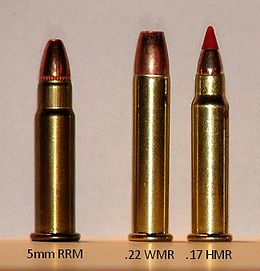

| 5 mm Remington Rimfire Magnum | ||||||||||||
|---|---|---|---|---|---|---|---|---|---|---|---|---|

| ||||||||||||
| Type | Rifle | |||||||||||
| Place of origin | United States | |||||||||||
| Production history | ||||||||||||
| Designer | Remington Arms Company | |||||||||||
| Designed | 1969 | |||||||||||
| Manufacturer | Remington | |||||||||||
| Produced | 1969–1973 (original production) 2008–present (current production) | |||||||||||
| Specifications | ||||||||||||
| Case type | Rimmed, bottleneck | |||||||||||
| Bullet diameter | .204 in (5.2 mm) | |||||||||||
| Neck diameter | .225 in (5.7 mm) | |||||||||||
| Shoulder diameter | .259 in (6.6 mm) | |||||||||||
| Base diameter | .259 in (6.6 mm) | |||||||||||
| Rim diameter | .325 in (8.3 mm) | |||||||||||
| Rim thickness | .050 in (1.3 mm) | |||||||||||
| Case length | 1.020 in (25.9 mm) | |||||||||||
| Overall length | 1.30 in (33 mm) | |||||||||||
| Primer type | Rimfire | |||||||||||
| Maximum pressure (SAAMI) | 33,000 psi (230 MPa) | |||||||||||
| Ballistic performance | ||||||||||||
| ||||||||||||
| Source(s): "Cartridges of the World",[1] | ||||||||||||
The 5 mm Remington Rimfire Magnumor5 mm RFM[2] is a bottlenecked rimfire cartridge introduced by Remington Arms Company in 1969. Remington chambered it in a pair of bolt-action rifles, the Model 591 and Model 592, but this ammunition never became very popular, and the rifles were discontinued in 1974.[3] About 52,000 rifles and 30,000 barrels for the T/C Contender pistol were sold during its brief production run. Remington discontinued the cartridge itself in 1982,[3] leaving owners with no source of ammunition.[4][5]
In 2008, the cartridge was reintroduced by Aguila Ammunition in collaboration with Centurion Ordnance.[6][7][8][9]
Remington designed a completely new, bottlenecked case that was somewhat similar to the older .22 Winchester Magnum, but stronger to handle the higher pressure of the 5 mm (0.20 in) at 37,000 psi (260 MPa).[2][10]
Between 1982 and 2008, no ammunition was being manufactured. Some firearms manufacturers even created conversion kits to allow the existing 5 mm guns to shoot other more-common cartridges.[5]
At the 2008 SHOT Show, Aguila Ammunition announced it would reintroduce the cartridge and begin commercial production of 5 mm RFM ammunition. Until 2019, the cartridges were sold in the United States of America under the Centurion brand. In 2019, Aguila Ammunition announced the company now offered two 5 mm RFM loads: one with a semi-jacketed hollow point bullet and a second with a full jacketed hollow point bullet. Both loads use a 30 gr (1.9 g) projectile and have a muzzle velocity of 2,300 ft/s (700 m/s).[11]
The 5 mm RRM offers higher velocity and more energy than the .22 WMR and the later .17 HMR.[6] It offers improved performance on small game and for varmint hunting, along with excellent accuracy.[1]
| Weight (grains) | Name | Brand | Type | Velocity (ft/s) | Energy (ft⋅lbf) | Trajectory (in) | ||||||||||||
|---|---|---|---|---|---|---|---|---|---|---|---|---|---|---|---|---|---|---|
| 0 yd | 50 yd | 100 yd | 150 yd | 200 yd | 0 yd | 50 yd | 100 yd | 150 yd | 200 yd | 0 yd | 50 yd | 100 yd | 150 yd | 200 yd | ||||
| 17 gr (1.1 g) | .17 HMR | Remington | AccuTip-V | 2,550 ft/s (780 m/s) | 2,380 ft/s (730 m/s) | 1,900 ft/s (580 m/s) | 1,620 ft/s (490 m/s) | 1,378 ft/s (420 m/s) | 245 ft⋅lbf (332 J) | 185 ft⋅lbf (251 J) | 136 ft⋅lbf (184 J) | 99 ft⋅lbf (134 J) | 72 ft⋅lbf (98 J) | 0 in (0 cm) | +0.1 in (0.25 cm) | 0 in (0 cm) | −2.6 in (−6.6 cm) | N/A |
| 38 gr (2.5 g) | 5 mm RFM | Remington | C.L. HP | 2,100 ft/s (640 m/s) | N/A | 1,605 ft/s (489 m/s) | 1,400 ft/s (430 m/s) | N/A | 372 ft⋅lbf (504 J) | N/A | 217 ft⋅lbf (294 J) | 165 ft⋅lbf (224 J) | N/A | 0 in (0 cm) | N/A | 0 in (0 cm) | −4.3 in (−11 cm) | N/A |
| 33 gr (2.1 g) | .22 WMR | Remington | AccuTip-V | 2,000 ft/s (610 m/s) | 1,703 ft/s (519 m/s) | 1,495 ft/s (456 m/s) | N/A | N/A | 293 ft⋅lbf (397 J) | 219 ft⋅lbf (297 J) | 164 ft⋅lbf (222 J) | N/A | N/A | 0 in (0 cm) | +0.6 in (1.5 cm) | 0 in (0 cm) | −4.5 in (−11 cm) | N/A |
When Remington discontinued production of 5 mm RFM ammunition, owners of Remington 591 and 592 rifles were left with excellent rifles but no ammunition for them. In 1994, Mike Craig of Seattle, Washington began working on a centerfire conversion of the 5 mm RFM, called the 5 mm Craig.[12][13] His company, Certech, also performed conversions of 5 mm rifles from rimfire to centerfire by altering the bolts and installing new firing pins, restoring them to use. Craig has since sold all the rights to the 5 mm Craig to Eagle View Arms of Shelton, Washington.[13]
For a brief time, Thompson Center Arms offered firearms in 5 mm Mag.[5]
At the 2008 SHOT show, Taurus International introduced the first handgun chambered for the 5 mm Remington Magnum Rimfire.[14]